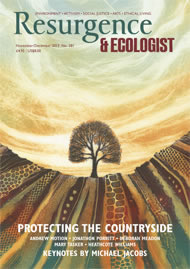For many years Henri Bortoft was a regular teacher at Schumacher College, his philosophy of wholeness forming the foundation of the MSc in Holistic Science. He died peacefully at his home in Matlaske, Norfolk, on 29 December 2012, aged 74 years, greatly loved and admired by family, friends, colleagues and all those transformed by his profound teachings.
To those not familiar with Bortoft’s work, the title Taking Appearance Seriously may at first seem strange. The play on words does not refer to the outward appearance of objects, but to the way in which we make sense and give meaning to the world. Through his carefully crafted prose Bortoft takes us on an incredible journey in which we learn to shift the focus of our attention away from our common-sense view of a fragmented world of subjects and objects, into our experiencing of what we experience. This is not just an exercise for the philosophically curious. If we are able to make this shift we enter into what Bortoft calls the dynamic way of seeing.
The genius of Taking Appearance Seriously lies in Bortoft’s ability to extend his previous work on the science of Goethe, guiding us into a deeper level of perception, i.e. this dynamic way of seeing. The importance of this, and also the reason why this dynamic way of thinking may be so hard for us to comprehend in the first instance is that we are trapped in the left-brain way of conceiving the world. By following Bortoft’s work slowly, we are led into a way of thinking that brings harmony and balance between the two sides of the brain.
If we can understand this, then we can understand why Bortoft’s work is of central importance to understanding the true nature of the many problems we face in the world today. Although many people proclaim systems thinking as the route to comprehending and solving the dichotomy of left brain, right brain, Bortoft warns us against confusing the artificial representation of our experience (and systems) in our left brain with the wholeness of our lived experience, which is first mediated in our right brains. What he teaches us to do is to evolve our thinking to one where we can comprehend systems dynamically and move from one side to the other smoothly.
Given that thinking in the knowledge economy is seen as the primary source of competitive advantage, few thinkers are able to match Bortoft’s ability to dive so deeply into the act of perception, plunging us into our sensory experiences, shifting our attention away from a focus on discrete objects in the world, into our seeing of objects, thus awakening within us a profound and intuitive capacity of cognition. Bortoft’s book The Wholeness of Nature, published in 1996, has been quoted by leading business thinkers such as Peter Senge, Otto Scharmer, H. Thomas Johnson and Anders Bröms. Taking Appearance Seriously builds on this book.
Systems thinkers often emphasise the need for synthesis in our thinking (right brain) as well as analysis (left brain), but through a slow, careful and meditative reading of Bortoft we are subtly shifted into understanding for the first time how the objects that we normally think of as ‘out there’ dynamically appear to us. This shift in thinking has huge implications for every dimension of business and organisational theory, such as storytelling in marketing, the organic design of workflow (such as management by means), and the facilitation of true dialogue for creativity and innovation.
Taking Appearance Seriously is a rare philosophical work of both outstanding quality and immense practicality. Bortoft deftly heals two and a half thousand years of fragmented thinking, teaching us to encounter Nature as “living being”. The ultimate importance of entering into the dynamic way of seeing may well be in the way in which it reawakens us to and reconnects us with the natural environment. When truly experienced, the impact is astounding, allowing us to comprehend and live lives of authentic wholeness.
For more about Bortoft’s work see www.tinyurl.com/hsj-bortoft







